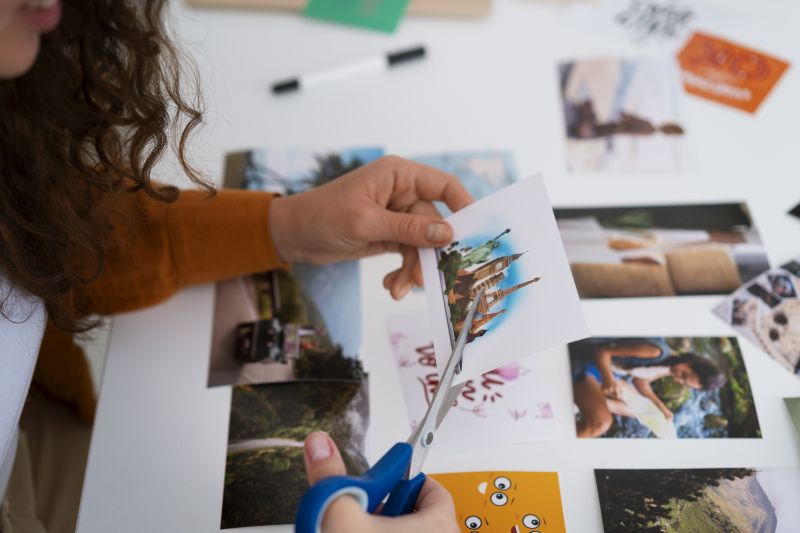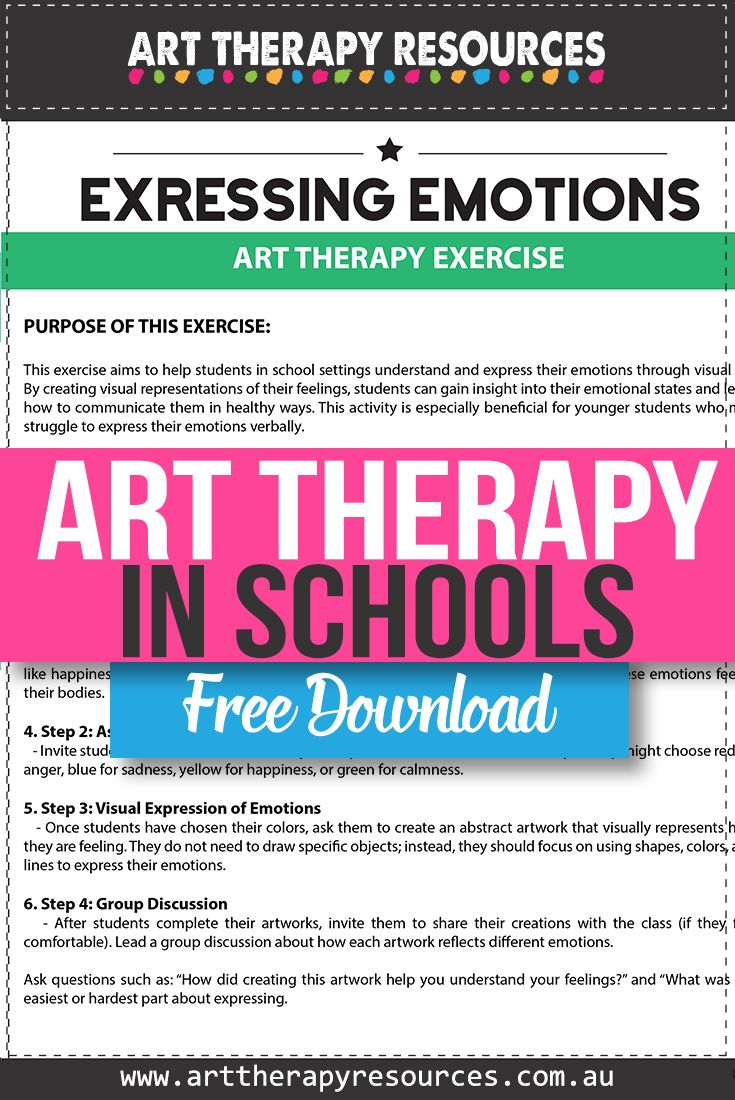THIS POST INCLUDES:
1. Potential of Art Therapy in Schools
2. Collaborating with Educators
3. Addressing Classroom Dynamics
4. Integrating Art Therapy in Schools
5. Free Download Art Therapy Exercise
POTENTIAL OF ART THERAPY IN SCHOOLS
The Educational Impact of Art Therapy
Art therapy provides a holistic means of supporting student development by integrating emotional, cognitive, and creative skills. Art therapy offers students a channel to explore their emotions, resolve internal conflicts, and foster self-esteem. When applied in a school setting, art therapy creates an inclusive and supportive environment, where both academic and emotional intelligence are nurtured.
Art therapy offers unique educational benefits beyond traditional teaching methodologies. When students engage in artistic creation, they are not only expressing themselves but also developing problem-solving skills, improving focus, and gaining a deeper understanding of their inner world. These elements are critical in fostering emotional resilience. Through the non-verbal language of art, students who struggle to articulate their feelings verbally can find a voice. In a school setting, this can lead to greater engagement, motivation, and improved behavior, as students feel more understood and validated. Art therapy also supports differentiated learning by offering a creative outlet for students with diverse learning needs, such as those with learning disabilities or emotional disturbances.
Art therapists in schools can directly address issues like anxiety, stress, and trauma that hinder academic performance. Studies suggest that emotional well-being is closely linked to academic achievement, and art therapy can bridge the gap by addressing underlying emotional issues that impede learning.
Benefits for Students, Educators, and the School Community
The benefits of integrating art therapy extend far beyond the individual student. For students, art therapy improves self-awareness and emotional expression. For educators, it can reduce classroom disruptions by helping students manage their emotions more effectively. For the broader school community, art therapy promotes a more inclusive and empathetic environment, which encourages collaborative problem-solving and enhances communication.
Educators gain insight into their students’ emotional states, which can improve relationships and create more meaningful connections. Furthermore, art therapy allows teachers to better identify at-risk students who may require additional support. On a school-wide level, introducing art therapy programs has been shown to reduce bullying and create a more inclusive atmosphere where all students feel valued.
Fostering a Positive School Climate through Art Therapy
Art therapy contributes to creating a positive school climate by encouraging emotional literacy and social-emotional learning. When students are given the tools to manage their emotions through creative expression, it can reduce feelings of isolation and improve their sense of belonging. A positive school climate encourages open dialogue about emotions and mental health, which can enhance peer relationships and promote mental well-being.
Art therapy initiatives can align with other school-based interventions, such as restorative justice practices, peer mediation, and conflict resolution programs. By teaching students how to express emotions constructively, art therapy can minimize disruptive behaviors, making the school a more harmonious place for both students and teachers.
COLLABORATING WITH EDUCATORS
Building Bridges: Collaborative Strategies with Educators
Collaboration between art therapists and educators is essential for effectively integrating art therapy into schools. Establishing clear communication and shared goals between the therapist and school staff ensures that art therapy is seen as an integral part of the school’s overall mission. Educators and therapists can work together to identify students who would benefit most from art therapy and find ways to incorporate artistic approaches into the curriculum.
Effective collaboration requires regular meetings, joint workshops, and shared progress reports. Art therapists can offer educators insight into therapeutic techniques that can be used in the classroom, such as creative journaling, role-playing, or visual relaxation exercises. By fostering a partnership, therapists and teachers can co-create environments where emotional expression is woven into daily classroom activities.
Professional Development for Educators: Integrating Art Therapy Techniques
Offering professional development workshops on art therapy can empower educators to integrate therapeutic principles into their teaching. Through training, teachers can learn basic art therapy techniques to foster creativity and emotional expression in their students. This could involve understanding how to create safe spaces for expression, recognizing the emotional content in students’ artwork, and using art as a tool for conflict resolution.
Professional development workshops can address specific classroom issues, such as working with trauma-exposed students or managing emotional dysregulation. Providing educators with strategies for recognizing early signs of distress and using art as a calming technique can help prevent larger behavioral issues and enhance student well-being.
*NOTE: It is important to note here that any training provided to educators should not imply that the educator will become a qualified art therapist.
In-Service Workshops: A Platform for Collaboration
In-service workshops are a collaborative platform where art therapists and educators can come together to exchange ideas and strategies. These workshops offer educators practical tools they can use in the classroom and provide a forum for discussing challenges and successes in implementing art therapy principles.
Workshops can focus on areas such as trauma-informed care, mindfulness, or fostering creativity in students with special needs. These collaborations also help establish a more cohesive approach to student wellness, ensuring that the entire school staff works together to support emotional growth and resilience.
ADDRESSING CLASSROOM DYNAMICS
Tailoring Art Therapy to Classroom Dynamics
Every classroom has its unique dynamic, shaped by the personalities, needs, and challenges of its students. Art therapists must adapt their interventions to meet these specific needs. This involves understanding the social-emotional makeup of the classroom, addressing group dynamics, and identifying any underlying issues that could be affecting student interactions.
For example, in a classroom with a high level of anxiety, the art therapist might incorporate calming, repetitive artistic tasks such as mandala creation or guided drawing to help students regulate their emotions. In contrast, a class struggling with cooperation might engage in collaborative art projects that emphasize teamwork and communication.
Individual and Group Sessions
Balancing individual and group art therapy sessions is critical in a school setting. Individual sessions allow for deep, personalized work with students, addressing specific issues such as trauma or grief. Group sessions, on the other hand, promote social skills, collaboration, and empathy among peers.
Art therapists in schools must assess when students would benefit from individual attention versus when group dynamics could provide essential peer support. For students struggling with social anxiety, group art therapy can help them practice interacting with others in a non-verbal, creative setting, gradually building their confidence in social situations.
INTEGRATING ART THERAPY IN SCHOOLS

Creating Art Spaces: Infusing Schools with Creative Energy
Creating designated spaces within schools for art therapy is essential for fostering an atmosphere conducive to creative expression. These spaces should be comfortable, safe, and equipped with various art materials to allow for spontaneous creativity. A well-thought-out art space can inspire students and encourage them to explore their thoughts and feelings through art.
Art spaces should also be inclusive, considering the needs of students with disabilities. Providing access to adaptive art materials or allowing for different sensory experiences ensures that all students can fully engage with the therapeutic process. Moreover, these spaces can serve as retreats for students who need a break from the academic pressures of the classroom.
Showcasing Student Art: Celebrating Achievements
Showcasing student artwork through school-wide exhibits or displays reinforces the value of art therapy and gives students a sense of accomplishment. These showcases not only validate the students’ creative efforts but also highlight the role of art therapy in supporting emotional well-being.
By celebrating art as a form of personal expression, schools send a message that emotional and creative development are as important as academic achievements. Regular showcases of student art can also open up conversations about emotions, allowing both students and faculty to engage in meaningful discussions about mental health.
This should of course be balanced with issues surrounding confidentiality and sensitive topics where a public display of art is not appropriate.
ART THERAPY EXERCISE
Art Therapy Exercise: Understanding and Expressing Emotions through Art
Purpose of the Exercise:
This exercise aims to help students in school settings understand and express their emotions through visual art. By creating visual representations of their feelings, students can gain insight into their emotional states and learn how to communicate them in healthy ways. This activity is especially beneficial for younger students who may struggle to express their emotions verbally.
Instructions:
1. Materials Needed: Paper, colored pencils, markers, paints, or other preferred art materials.
2. Introduction: Begin by explaining that everyone experiences a range of emotions every day, and it’s okay to feel different emotions at different times. Emphasize that art can be a powerful way to understand and express these feelings.
3. Step 1: Identifying Emotions
– Ask students to think about the different emotions they have experienced recently. Discuss common feelings like happiness, sadness, anger, and excitement. Encourage students to think about how these emotions feel in their bodies.
4. Step 2: Assigning Colors to Emotions
– Invite students to choose colors that they feel represent their emotions. For example, they might choose red for anger, blue for sadness, yellow for happiness, or green for calmness.
5. Step 3: Visual Expression of Emotions
– Once students have chosen their colors, ask them to create an abstract artwork that visually represents how they are feeling. They do not need to draw specific objects; instead, they should focus on using shapes, colors, and lines to express their emotions.
6. Step 4: Group Discussion
– After students complete their artworks, invite them to share their creations with the class (if they feel comfortable). Lead a group discussion about how each artwork reflects different emotions. Ask questions such as: “How did creating this artwork help you understand your feelings?” and “What was the easiest or hardest part about expressing
FREE DOWNLOAD: Art Therapy Exercise
SIGN UP below to gain access to our RESOURCE LIBRARY and download the FREE Art Therapy Exercise.

BUILD YOUR ART THERAPY REFERENCE MATERIALS:
Pin this image to your Pinterest board.

SHARE KNOWLEDGE & PASS IT ON:
If you’ve enjoyed this post, please share it on Facebook, Twitter, Pinterest. Thank you!



